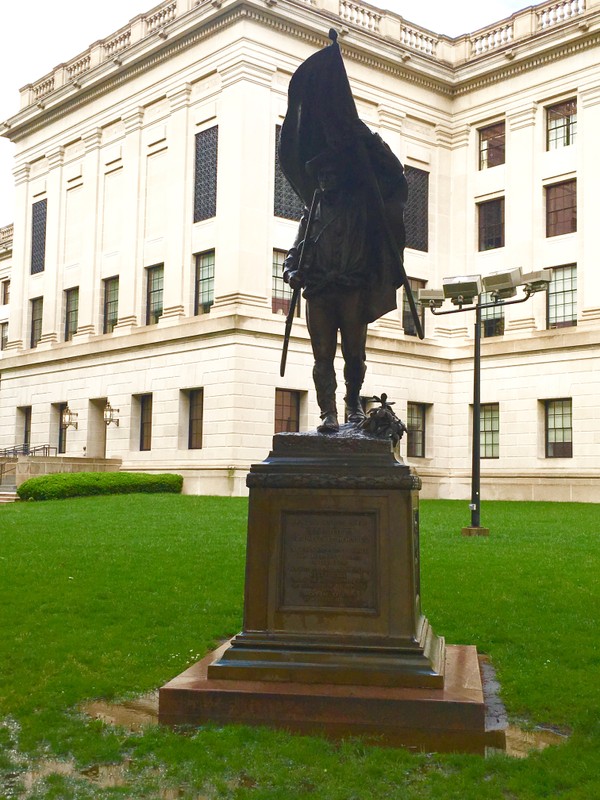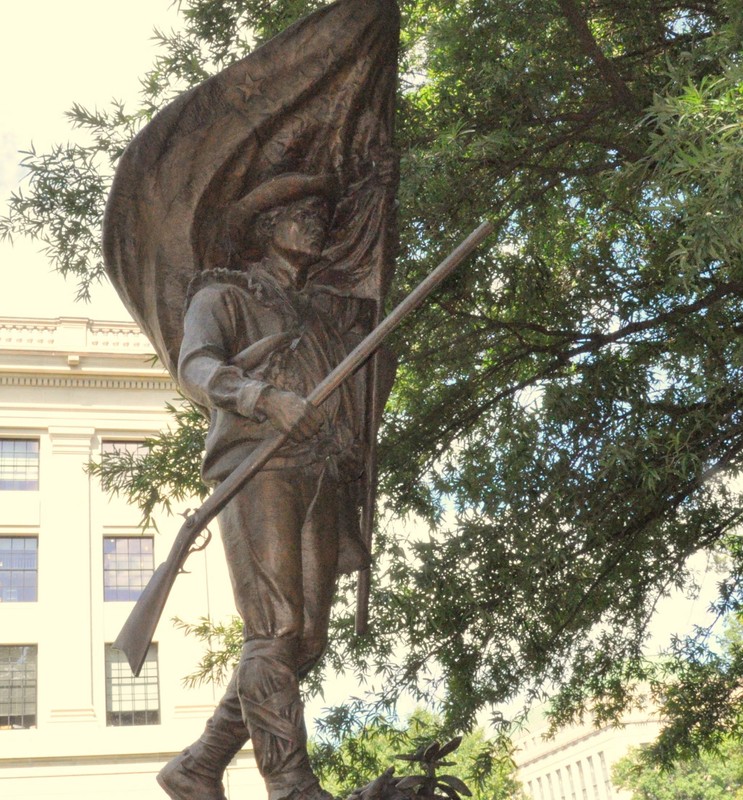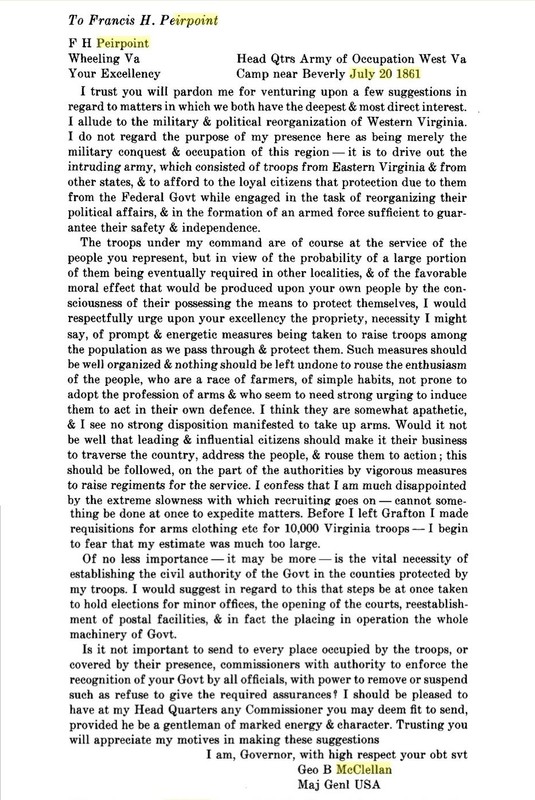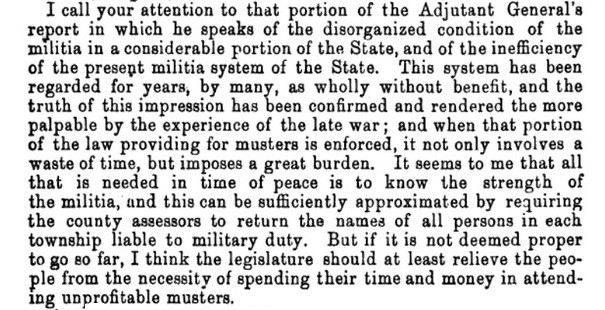Mountaineer Soldier Statue
Introduction
Text-to-speech Audio
In response to the dedication of a statue honoring Clarksburg, West Virginia native and Confederate General Thomas "Stonewall" Jackson at the old State Capitol in downtown Charleston, West Virginia, veterans of the Union Army received an equivalent statue sculpted by Henry Kirke Bush-Brown in 1912. The bronze statue depicts a pro-Union citizen militiaman carrying a flag and musket, while the two reliefs on the base depict Mountaineer home life. Colonel William Seymour Edwards, former speaker of the West Virginia House of Delegates was instrumental in the erection of the statue.
Images
The Mountaineer Soldier statue.


Gen. McClellan to Gov. Pierpont, July 21, 1861

Gov. Boreman on the state militia, January 15, 1867

Backstory and Context
Text-to-speech Audio
The Mountaineer Soldier statue is located on the northeast corner of the West Virginia State Capitol. It was unveiled at the old State Capitol on Capitol Street in downtown Charleston on December 10, 1912. The guiding force for this monument was Col. William Seymour Edwards, speaker of the WV House of Delegates in the 1890s. Edwards personally helped raise funds for the project. The Mountaineer Statue was a symbol of the men of Western Virginia who volunteered and formed themselves into Home Guards to respond to President Lincoln's call to arms in 1861. By their actions, they helped to save Western Virginia for the Union. The base of the monument states: "Erected to commemorate the valor of those who on April 15, 1861, in instant response to the first call of Abraham Lincoln formed themselves into the intrepid Home Guards who held in check unaided the forces of Wise, and Lee, and Jackson, until the federal armies came..."
The monument represents a popular notion that is not necessarily historically accurate. The militia system in western Virginia was disrupted by the war and not functional in many counties. Militia companies in the southern counties generally supported the Richmond government, many eventually entering Confederate service. Gen. McClellan wrote to Gov. Pierpont on July 21, 1861, saying "...I see no strong disposition manifested to take up arms...I confess that I am much disappointed by the extreme slowness with which recruiting goes on...Before I left Grafton I made requisitions for arms clothing etc for 10,000 Virginia troops-I begin to fear that my estimate was much too large."
Pierpont wrote to Lincoln on Sept. 21, 1861, saying “There is much public condemnation of Western Va. because the people do not defend themselves from the rebbel forces in their midst.” As historian Charles H. Ambler noted "Admitted apathy toward the Union in its militant capacity was great."(Pierpont, pg. 99) A New York Times reporter travelling with the Union army in West Virginia wrote on Aug. 23, 1861, "I remark, however, that it is difficult to comprehend the reluctance of many of the Union Virginians to wage war against their rebel enemies...it is aggravating to the Army that the Western Virginians do not appropriate this part of operations to themselves.."
While local militia and homeguards sometimes performed brave actions at critical moments, such as during the Jones-Imboden raid in 1863, the milita system was not very effective. In his address to the state legislature on January 15, 1867 Gov. Boreman stated: "This [militia] system has been regarded for years, by many, as wholly without benefit, and the truth of this impression has been confirmed and rendered the more palpable by the experience of the late war;".
It took sculptor Henry K Bush-Brown two years to find the model and three years to actually sculpt the statue. Bush-Brown modeled the statue after Ellis Hamrick, a mountaineer from Webster County, West Virginia. Col. William Seymour Edwards sent Hamrick to Washington to model for the statue. The statue was originally modeled after one of Hamrick's brothers, but the brother passed away during the creation of the statue. As a result, Ellis Hamrick was chosen as the model. The eight-foot monument was dedicated by Colonel Edwards "To the hallowed memories of the brave men and devoted women who saved West Virginia to the Union."
The statue is over a century old, and it has been restored by the Save Outdoor Sculpture (SOS!) program. The program is a collaborative project with Heritage Preservation and the Smithsonian's National Museum of American Art. Moisture damage and corrosion affected the statue, and the restoration included mending those damages and repairing the bronze patina and stone base.
Sources
Dick, and Debbie. "West Virginia Capitol (Mountaineer Soldier Statue), Charleston, WV - 2104-09-05." September 6, 2014, Accessed July 2, 2019. http://www.dickndebbietravels.com/?attachment_id=20497.
Sibray, David. Memory of the mountaineer lives on at W.Va. capitol statue. West Virginia Explorer. May 06, 2018. Accessed July 01, 2019. https://wvexplorer.com/2018/05/06/mountaineer-lives-on-wv-statue/.
Wallace, Jim. A History of the West Virginia Capitol: The House of State. The History Press, 2012.
Wallace, Jim, A History of the West Virginia Capitol: The House of State. The History Press, 2012. Cohen, Stan, and Richard Andre, Capitols of West Virginia: A Pictorial History. Charleston, WV: Pictorial Histories Publishing, 1989.
Work to Begin next week to restore two State Capitol sculptures. West Virginia Department of Arts, Culture, and History. Accessed July 01, 2019. http://www.wvculture.org/shpo/statuerenov.html.
Ambler, Charles H.. Francis H. Pierpont: Union War Governor of Virginia and Father of West Virginia. Chapel Hill, North Carolina. University of North Carolina Press, 1937.
Sears, Stephen W.. The Civil War Papers of George B. McClellan: Selected Correspondence, 1860-1865. New York, New York. Ticknor & Fields, 1989.
Journal of the Senate of the State of West Virginia for the Fifth Session, Commencing January 15, 1867. Wheeling, West Virginia. John Frew, 1867.
Abraham Lincoln papers: Series 1. General Correspondence. 1833-1916: Francis H. Peirpoint to Abraham Lincoln, Thursday, September 12, 1861 (Situation in western Virginia), Library of Congress. Accessed August 27th, 2023. https://www.loc.gov/item/mal1162200/.
THE ARMY OF WESTERN VIRGINIA.; Gurrilla Warfare Movements of the Rebel Leaders Lee's Attempts to Push Through Our Lines Foiled, &c., The New York Times. Accessed August 27th, 2023. https://www.nytimes.com/1861/08/23/archives/the-army-of-western-virginia-gurrilla-warfare-movements-of-the.html.
The Civil War Papers of George B. McClellan: Selected Correspondence, 1860-1865.
Journal of the Senate of the State of West Virginia for the Fifth Session, Commencing January 15, 1867
